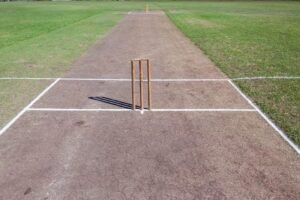Dimensions
These are the Cricket Pitch dimensions in different units.
Length
| Unit | Value |
| Yards | 22 |
| Metres | 20.12 |
| Feet | 66 |
Breadth
| Unit | Value |
| Metres | 3.05 |
| Feet | 10 |
Yes, for those who have just seen cricket on television, it is quite difficult to get an idea about the length of the pitch and its breadth.
You can either visit a local cricket ground or take the help of a measuring tape to see what are the dimensions of a typical pitch.
Are The Dimensions Of Pitch Always Maintained In Cricket?
Yes, official rules dictate this to be followed. Even domestic cricket leagues follow this and as many of you may know, 22 yards is something that is synonymous with cricket. However, unofficial games like local leagues might not follow this including this with a number of other rules. Mostly, it is due to the lack of space and area.
Batting Pitch Vs Bowling Pitch
Some pitches are better for batsmen and others, for bowlers. You will see this in the types of pitches section that we are going to discuss later. The impact of this is that the result of the toss becomes important. A point to note is that as the match progresses, the pitch being used deteriorates most of the time. Hence, the skills of the bowlers and batsmen both get tested.
Firoz Shah Kotla Pitch Controversy
Date
27th December 2009
Teams
India Vs Sri Lanka
Format
ODI
This was perhaps a bizarre controversy that involved the Kotla pitch offering uneven bounce. This made it difficult for the match officials to allow the game to continue. Similar incidents have happened before in India but this one gained prominence as it was happening in the capital. The role of pitch curators is also important as this incident demonstrates that. Now, let’s discuss the types of cricket pitches.
Types Of Cricket Pitches
-
Based On Surface
Green
This doesn’t mean that the pitch is covered excessively with grass. These types of pitches are great for seamers as they can get the bowl to swing. Batsmen need to be extremely skilled to avoid getting dismissed and for being able to score runs. For spinners, they don’t offer much turn and hence, they aren’t able to have an advantage over the batsman on the crease. They are mostly found in countries like Australia, South Africa, and England.
Dusty
These types of pitches are found in India, Pakistan, and Bangladesh. Their surface isn’t that hard so the bowl tends to stay low. This is also one of the reasons why some Indian batsmen face issues when they go on a tour abroad as they aren’t that accustomed to those playing conditions. Spinners in these types of pitches have to put some efforts to get that required turn for taking wickets.
Dead
These are another type of pitches that are common in the Indian subcontinent. For making them, no grass is allowed and the moisture quantity is also kept at the minimum. Dead pitches are very advantageous to the batsmen as they offer little help to the bowlers. This is why you see very high scores sometimes in T20 and ODI matches.
-
Based On The Movement Of The Ball
Seaming
Those that are advantageous for pacers and fast bowlers.
Spinning
These types of pitches can be observed on the 4th and 5th day of an ongoing test match. Those spinners who know how to use their wrists will find these pitches great for taking crucial wickets.
Conclusion
While any given pitch does play an important part in how the match goes on, there are other factors that have become more important. Fitness for instance is something that can greatly assist a batsman or a pacer to bat and bowl better. This has also been observed that working on technique too helps a lot.



